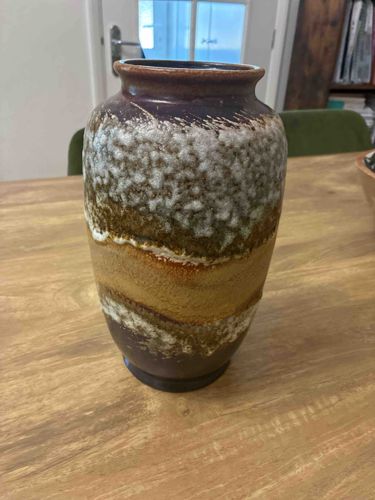
West German Fat Lava Glaze Ceramic Vase
This is a ceramic vase, likely stoneware, featuring a distinctive fat lava glaze typical of West German pottery from the mid to late 20th century, specifically the 1960s to 1970s. The vase has a classic ovoid or amphora-like body that tapers towards a narrower, slightly flared rim and a stable, flat base. Its approximate height appears to be around 8-12 inches based on its apparent scale on the wooden table. The coloration is complex and textural, with a primary palette of earthy tones including dark brown, sandy beige/ochre, and off-white/cream. The upper section is dominated by a dark, almost purplish-brown glaze with a textured, pitted, "fat lava" effect in an off-white or mottled greyish-white. Below this, there's a smooth band of warm, golden-brown or ochre, possibly with subtle striations. Towards the base, the dark brown reappears, again with white or lighter speckled accents, creating a layered, organic appearance. There are no readily visible chips, cracks, or significant damage, suggesting good overall condition for its age. The glaze appears intact, with a rich, unblemished patina. No distinct maker's marks or signatures are discernible from the provided image, but the style strongly indicates a European, likely German, origin. The craftsmanship is robust, characterized by the heavy application and specific chemical reaction of the glazes creating the characteristic textured surface. This type of pottery is known for its durability and unique artistic expression, often mass-produced but with individual variations due to the glazing process.
AI-Generated Appraisal Disclaimer
Estimated Value
$150-250
Basic Information
Category
Vase
Appraised On
December 3, 2025
Estimated Value
$150-250
Item Description
This is a ceramic vase, likely stoneware, featuring a distinctive fat lava glaze typical of West German pottery from the mid to late 20th century, specifically the 1960s to 1970s. The vase has a classic ovoid or amphora-like body that tapers towards a narrower, slightly flared rim and a stable, flat base. Its approximate height appears to be around 8-12 inches based on its apparent scale on the wooden table. The coloration is complex and textural, with a primary palette of earthy tones including dark brown, sandy beige/ochre, and off-white/cream. The upper section is dominated by a dark, almost purplish-brown glaze with a textured, pitted, "fat lava" effect in an off-white or mottled greyish-white. Below this, there's a smooth band of warm, golden-brown or ochre, possibly with subtle striations. Towards the base, the dark brown reappears, again with white or lighter speckled accents, creating a layered, organic appearance. There are no readily visible chips, cracks, or significant damage, suggesting good overall condition for its age. The glaze appears intact, with a rich, unblemished patina. No distinct maker's marks or signatures are discernible from the provided image, but the style strongly indicates a European, likely German, origin. The craftsmanship is robust, characterized by the heavy application and specific chemical reaction of the glazes creating the characteristic textured surface. This type of pottery is known for its durability and unique artistic expression, often mass-produced but with individual variations due to the glazing process.
Get Your Items Appraised
Instant estimates of your treasures with AI-powered instant appraisals